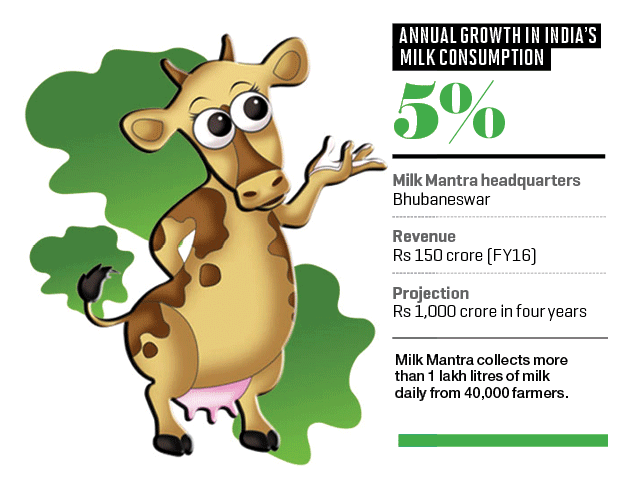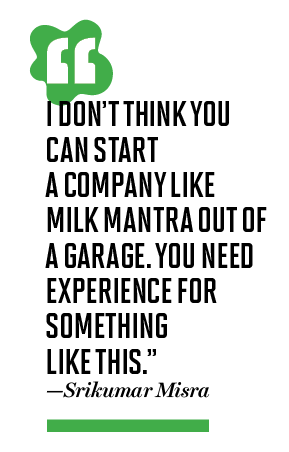Formless splashes of Milky Moo’s trademark green catch the eye across Odisha, amid the unsubtle red of Coca-Cola, Airtel, and Vodafone that dominates the outdoor. The fresh milk brand’s bovine mascot, Moo, daintily holds an orange flower in her mouth. Her round, endearing eyes form the Os in her name.
Moo promises milk you can trust:“Truly Pure. No need to boil.” The message resonates with customers in Odisha, where not too many local brands are known for consistent quality or marketing ingenuity. Milk Mantra, Odisha’s buzziest startup and the company behind Milky Moo and sister brand MooShake, is making people sit up and take notice.
Founder Srikumar Misra, 39, returned to his home state seven years ago, giving up a life of relative luxury in London, where he headed the global mergers and acquisitions division of Tata Tea-Tetley. “I was not building anything or impacting lives [in London],” he explains, while I admire the company’s Moo-themed headquarters in Bhubaneswar that could easily belong at a startup hub like Bengaluru.
When searching for business ideas, a dairy play made the most sense, says Misra. It was his chance to make a difference in his milk-deprived home state, which brings up the rear in most human development indicators nationwide.
Today, Milk Mantra is among a small group of VC-backed food and beverages firms in India. (Others include Hector Beverages known for its Paper Boat brand, Dropkaffe Food & Beverages, Rakyan Beverages, which sells fresh juices under the RAW Pressery brand, and B9 Beverages, led by another Fortune India 40 Under 40 entrepreneur Ankur Jain, which makes the Bira91 brand of beers.) The firm doubled revenues to Rs 150 crore in the last financial year, Misra claims. It also clocked an operational profit for the first time. Misra’s big goal is to create a Rs 1,000 crore dairy business within four years. All this after several investors, mostly enamoured by e-commerce, spurned his proposal.

Misra’s model sets him apart from many other private players. He collects milk directly from farmers rather than through intermediaries. That helps him remove inefficiencies in the system, ensure quality of milk, and reward the farmer more: something that fits into Misra’s ideas of conscious capitalism. Think of it as a privately funded, updated version of the white revolution, which helped India’s milk production grow fivefold in the latter half of the 20th century.
Suhas Misra, co-founder of Hector Beverages (he has since left the company) and an investor in a premium dairy company in Haryana, says the dairy value chain is ripe for private enterprise.“Most of the changes in the dairy sector happened many decades back. Milk Mantra has brought the entrepreneurial idea back to the dairy sector,” he says.
Milk Mantra’s website spells out a simple formula: Happy Farmers=Happy Cows=Best Milk. Last year, it tied up with State Bank of India, NABARD, and IDBI Bank to provide easy loans to farmers as part of its “ethical milk-sourcing programme”, which commits the right price for the milk “each and every time”. The company also helps cattle owners improve hygiene and incentivises quality milk.
Says Misra: “The first principle in our sourcing programme is pricing transparency. As is standard, we have a rate chart calibrated according to the fat content. Many cooperatives are leaky and the farmer doesn’t get what is on paper. Our understanding is that there could be a difference of as much as Rs 4 per litre.”
LAXMI DHAR, my driver in Bhubaneswar, explains why he loves Moo. “The milk is thicker than what OmFed (Odisha’s milk co-operative) sells. It is good for children, and we have been buying only Milky Moo for the last four years even though it is slightly more costly,” he says. Many people I meet on the streets of Bhubaneswar over the next couple of days echo Dhar’s opinion.
Quality isn’t the only differentiation between OmFed and Milk Mantra. OmFed’s presence on walls and posters appear to have weathered many years of neglect.
In a way, OmFed’s fading adverts reflect the partly crumbling legacy of India’s co-operative movement that sprung up in the 1970s. These co-operatives, backed by aid from a host of western nations, sparked the white revolution, turning India into the world’s No. 1 milk producer. The frontrunner has been Gujarat, where Amul, India’s largest food brand, raked in sales of more than Rs 23,000 crore in FY16. Mother Dairy in Delhi, Nandini in Karnataka, and Milma in Kerala have also nurtured strong brands. However, not many others have managed to replicate their success.
Take OmFed, for instance. Figures from 2011 (these are the latest available) show it collected only 10% of the milk produced in the state, lagging the national collection average of 22%. There is little to suggest the situation has improved since. This inefficiency has translated into low availability of milk—an important source of protein.
Says Chaitra Narayan, associate director, visionary science practice, Frost & Sullivan: “The highest per capita consumption of milk is in the North followed by the West and South. East has the least consumption.” Ironically, industry sources say relatively poor eastern states such as Odisha and West Bengal are among the biggest local markets for expensive milk powder, a substitute for the real thing.
Overall, India’s per capita consumption of dairy products remains low, about a sixth of Europe’s 360 litres. The average output of an Indian cow is roughly a seventh of cattle in the U.S. “Despite being the world’s largest producer, the dairy sector is by and large in the primitive stage of development and modernisation,” a report from Research and Markets, which collates research from analysts, points out.
That needs to change, as economic expansion feeds growth in milk consumption, which is outpacing growth in supply. The National Dairy Development Board expects demand to cross 200 million tonnes by 2022. According to Kotak Securities, milk production in India increased 4.3% annually to 134 billion litres in 2014 from 113 billion litres in 2010. In contrast, the report pegs annual consumption growth at 5%.
However, building a sustainable business model in dairy is fairly complex. Given milk’s perishable nature, you need depth in sourcing and logistics. Milk Mantra, which owns processing plants in Sambalpur and Konark, has begun well. In 2014-15, OmFed collected about 4.4 lakh litres of milk daily from 2.77 lakh farmers. Milk Mantra claims to have reached a quarter of that already with a network of 40,000 farmers, indicating a better yield per farmer. (Amul’s network of 36 lakh farmers across 18,600 villages in Gujarat procured an average 180 lakh litres of milk per day last fiscal.) Milk Mantra has also installed bulk milk coolers in villages across Odisha.
If Misra is able to scale the company, it will beef up the organised sourcing chain, which only accounts for a third of the country’s supply right now. In December 2014, the company acquired Sambalpur-based Westernland Dairy, which helped take Moo beyond Odisha, to Jharkhand
and Chhattisgarh.
Fidelity Growth Partners (now renamed Eight Roads Ventures), one of the leading investors in Milk Mantra, is bullish on the idea of expansion. “Given the lack of development in eastern India, the region faces a milk deficit. There is a significant opportunity for well-run dairies to establish themselves and build a formidable supply chain, as competition is weak,” it says, according to a report in financial daily Business Standard.
To be certain, Milk Mantra is not the only private company making a play in dairy. Private players procure about 6% of the nation’s milk but many shy away from marketing it directly to consumers. Take the listed, Navi Mumbai-headquartered Prabhat Dairy, where institutional sales contributed 75.8% of FY15 revenue.

Relatively low margins of 4% to 5% are a major red flag in the fresh milk business. But of late, private investment has flowed into the market for value-added products such as butter, curd, and milkshakes. The thesis: Rising incomes will spur demand for milk-derived products in the world’s fastest growing major economy. The consumption in this segment has been surging 25% year on year. It is also more profitable than fresh milk, pulling in margins of up to 18%.
The $5 billion (Rs 31,585 crore) Godrej Group in December forayed into the milk products business, purchasing a majority stake in Creamline, which operates in southern India. Parag, Nestlé, Danone, and Britannia are the other big names in the fray.
Milk Mantra too is planning inroads in the niche dairy products market. Misra sees milkshakes as his ticket to expansion: Fresh dairy has a lower shelf life, so will remain limited to eastern markets. In 2015, Misra launched the milkshake brand MooShake in Bengaluru, followed by Bhubaneswar, Hyderabad, and Kolkata.
To create brand differentiation, MooShake is banking on a special ingredient: curcumin, a turmeric extract. Misra hopes the blend—he offered me a sample which I quite enjoyed—will prove popular among Indians who add turmeric to milk for its health benefits. The company claims three years of research and testing went into MooShake.
When I ask Dhar, my driver, if he knows who runs Milk Mantra, he gives an answer that is as amusing as it is revealing: “I have heard it is run by a kid.” The adventure sports-loving Misra may well be flattered by the description given his real age, but it is also a reminder that in Bhubaneswar, he is a rare breed—a startup “kid”, cast adrift from the endless stream in Bengaluru or Mumbai. “Being an entrepreneur is a lonely journey but it becomes lonelier here,” he says.“You don’t have other entrepreneurs to have a beer with and talk about how they are dealing with stuff.”
Recruiting partners and employees is also a challenge. “We are an island out here. Just imagine building a brand but not having an advertising agency to talk to. You need a packaging designer, there is no one here. You want to develop a proper website, but there is no one. Forget the larger issues of getting a venture capitalist interested in a space like dairy…” his voice trails off.
In London, well-wishers attempted to dissuade Misra and his wife Rashima (executive director at Milk Mantra) from returning to Odisha, which was still recovering from ill-fated bets on mining, such as the infamous Posco investment.
Misra had to dig deep. It took him 18 months to raise money from 22 angel investors and Aavishkaar, a social fund (which has also invested in dairy companies Osam and Shree Kamdhenu), but only after he reduced the ticket size.
“In dairy you require investment into infrastructure and supply chain before you can produce even a packet of milk. I needed $5 million just to get started. Half of the money was raised as debt from SBI and IDBI, for which we pledged my wife’s jewellery as collateral,” says Misra.
Stints with the Tatas in several countries—including China, South Africa, Poland and Britain—had provided Misra deep insights into global markets for packaged and value-added food products. “I don’t think you can start a company like Milk Mantra out of a garage,” he says. “You need experience for something like this.”
The experience is helping create a unique brand in a market that is starting to heat up. With Milk Mantra though, there is no need to boil.










Leave a Comment
Your email address will not be published. Required field are marked*